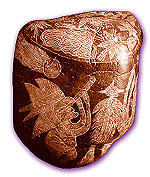
J U R A S S I C A R T
|
Because the land is at a high altitude and gets little rain, scientists have often wondered how anyone could maintain a sustainable living in this harsh environment, let alone perform the work required to create these amazing structures. This is just one of the many mysteries to be found in the region. On neighboring mountain tops, the intact remains of walls and buildings can be seen. This architecture is all made from massive stones-- some weighing as much as a locomotive-- each meticulously carved and transported to the high peaks from a quarry some five miles away. The precision of each stone's final finish is so exact that there was no need for mortar or cement. The stones are joined so tightly that not even a pin can be inserted between them. When the Spanish came to Peru and discovered this construction, they asked the native people if they had made these huge monuments. But the natives of Peru had only legends of "the ancients" that came and went, long before they established their villages. Their identity is still a mystery.
 Images on the Ica Stones show human type figures riding in Pterodactyls while hunting dinosaurs (left), an amazing global map showing the continents (center), and other activities not yet understood.
In this area, rain is infrequent. In the mid 1960's it rained a lot. The dry washes quickly filled to capacity and normally calm rivers were scoured by the torrential flood. In a small town near the Nazca lines, the narrow Ica River was eroded away along the banks, revealing several hundred carved stones that had been buried in subterranean chambers. As the water receded, the carved stones were left on the Ica's banks.
The stones come in all sizes. There are small ones that can easily fit your palm and there are rocks as large as a dog. All of the stones have images that have been carved with continuous lines etched into the rock surface. The etching reveals a lighter color than the original dark varnish of age, yet the etched grooves also bear traces of this varnish, indicating that the carving was done in ancient times.  Curious images of a comet and an astronomer, using an object that looks like a telescope, are found on the stones

|
.
.
.
.
.
.
If you have a suggestion or history related article to submit, send it to:
Editor/viewzone.com
myristicin@hotmail.com

 High atop the Andes Mountains, the "Rockies" of South America, there is an arid region in Peru that is both unusual and unnatural. Seen from the air, this region could easily be mistaken for an abandoned airport. Someone has carefully cleared and carved a series of laser straight lines that span many kilometers. Most of these lines are just wide enough to be called a path. Other areas form huge rectangles and trapezoids, hundreds of meters in width and length. Indeed, it looks as if the area was made to accommodate a fleet of DC-747's, But these "runways" are thousands of years old.
High atop the Andes Mountains, the "Rockies" of South America, there is an arid region in Peru that is both unusual and unnatural. Seen from the air, this region could easily be mistaken for an abandoned airport. Someone has carefully cleared and carved a series of laser straight lines that span many kilometers. Most of these lines are just wide enough to be called a path. Other areas form huge rectangles and trapezoids, hundreds of meters in width and length. Indeed, it looks as if the area was made to accommodate a fleet of DC-747's, But these "runways" are thousands of years old. As the locals began to collect these stones, a particular image of a fish caught the eye of Dr. Javier Cabrera, the town's physician. Dr. Cabrera recognized the outlined image as that if an extinct species of fish. His curiosity peaked, he sought more of these stones. Gradually, the villagers knew that he was interested in these strange objects and so they gave him what is now his collection-- something Cabrera calls his "library"-- of stone enigmas.
As the locals began to collect these stones, a particular image of a fish caught the eye of Dr. Javier Cabrera, the town's physician. Dr. Cabrera recognized the outlined image as that if an extinct species of fish. His curiosity peaked, he sought more of these stones. Gradually, the villagers knew that he was interested in these strange objects and so they gave him what is now his collection-- something Cabrera calls his "library"-- of stone enigmas.